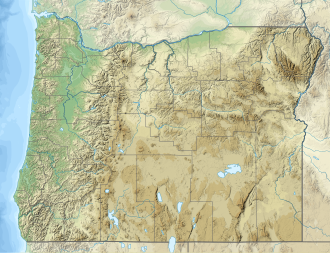
Back نهر ديستشوتيس ARZ Deschutes River (suba sa Tinipong Bansa, Oregon) CEB Deschutes River Danish Deschutes River (Columbia River) German Río Deschutes Spanish Deschutes River (Oregon) French Deschutes River (Oregon) Italian Deschutes (elv) NB Deschutes (dopływ Kolumbii) Polish Дешут Russian
| Deschutes River | |
|---|---|
 The Deschutes River near its mouth on the Columbia. Pioneers camped on the bluff to the left. | |
 Map of the Deschutes watershed | |
| Etymology | From Rivière des Chutes, used by early-19th-century fur traders[2] |
| Location | |
| Country | United States |
| State | Oregon |
| County | Deschutes, Jefferson, Sherman, and Wasco |
| Physical characteristics | |
| Source | Little Lava Lake |
| • location | Cascade Range, Deschutes County, Oregon |
| • coordinates | 43°54′33″N 121°45′40″W / 43.90917°N 121.76111°W[1] |
| • elevation | 4,747 ft (1,447 m)[3] |
| Mouth | Columbia River |
• location | between Fairbanks and Biggs Junction, on border between Wasco and Sherman counties, Oregon |
• coordinates | 45°38′07″N 120°54′52″W / 45.63528°N 120.91444°W[1] |
• elevation | 164 ft (50 m)[1] |
| Length | 252 mi (406 km)[4] |
| Basin size | 10,500 sq mi (27,000 km2)[5] |
| Discharge | |
| • location | Moody, 1.4 miles (2.3 km) from mouth[5][6] |
| • average | 5,824 cu ft/s (164.9 m3/s)[5][6] |
| • minimum | 2,400 cu ft/s (68 m3/s) |
| • maximum | 70,300 cu ft/s (1,990 m3/s) |
| Type | Scenic, Recreational |
| Designated | October 28, 1988 |
The Deschutes River (/dəˈʃuːts/ də-SHOOTS) in central Oregon is a major tributary of the Columbia River. The river provides much of the drainage on the eastern side of the Cascade Range in Oregon, gathering many of the tributaries that descend from the drier, eastern flank of the mountains. The Deschutes provided an important route to and from the Columbia for Native Americans for thousands of years, and then in the 19th century for pioneers on the Oregon Trail. The river flows mostly through rugged and arid country, and its valley provides a cultural heart for central Oregon. Today the river supplies water for irrigation and is popular in the summer for whitewater rafting and fishing.
The Deschutes flows generally north, as do several other large Oregon tributaries of the Columbia River, including the Willamette and John Day.
- ^ a b c "Deschutes River". Geographic Names Information System (GNIS). United States Geological Survey (USGS). November 28, 1980. Retrieved October 13, 2008.
- ^ McArthur, Lewis A.; McArthur, Lewis L. (2003). Oregon Geographic Names, Seventh Edition. Portland, Oregon: Oregon Historical Society Press. pp. 282–83. ISBN 0-87595-277-1.
- ^ Source elevation derived from Google Earth search using GNIS source coordinates.
- ^ "Online Topographic Maps from the United States Geological Survey". TopoQuest. Retrieved October 13, 2008.
- ^ a b c "Water-Data Report 2013: 14103000 Deschutes River at Moody, Near Biggs, OR" (PDF). United States Geological Survey. 2014. Retrieved September 25, 2014.
- ^ a b The average discharge rate was calculated from USGS records from the Moody gauge of water years 1898–99 and 1907–2013.

